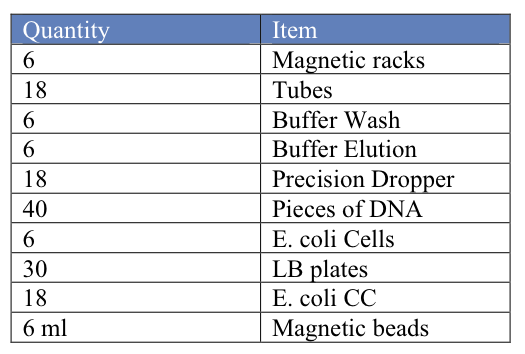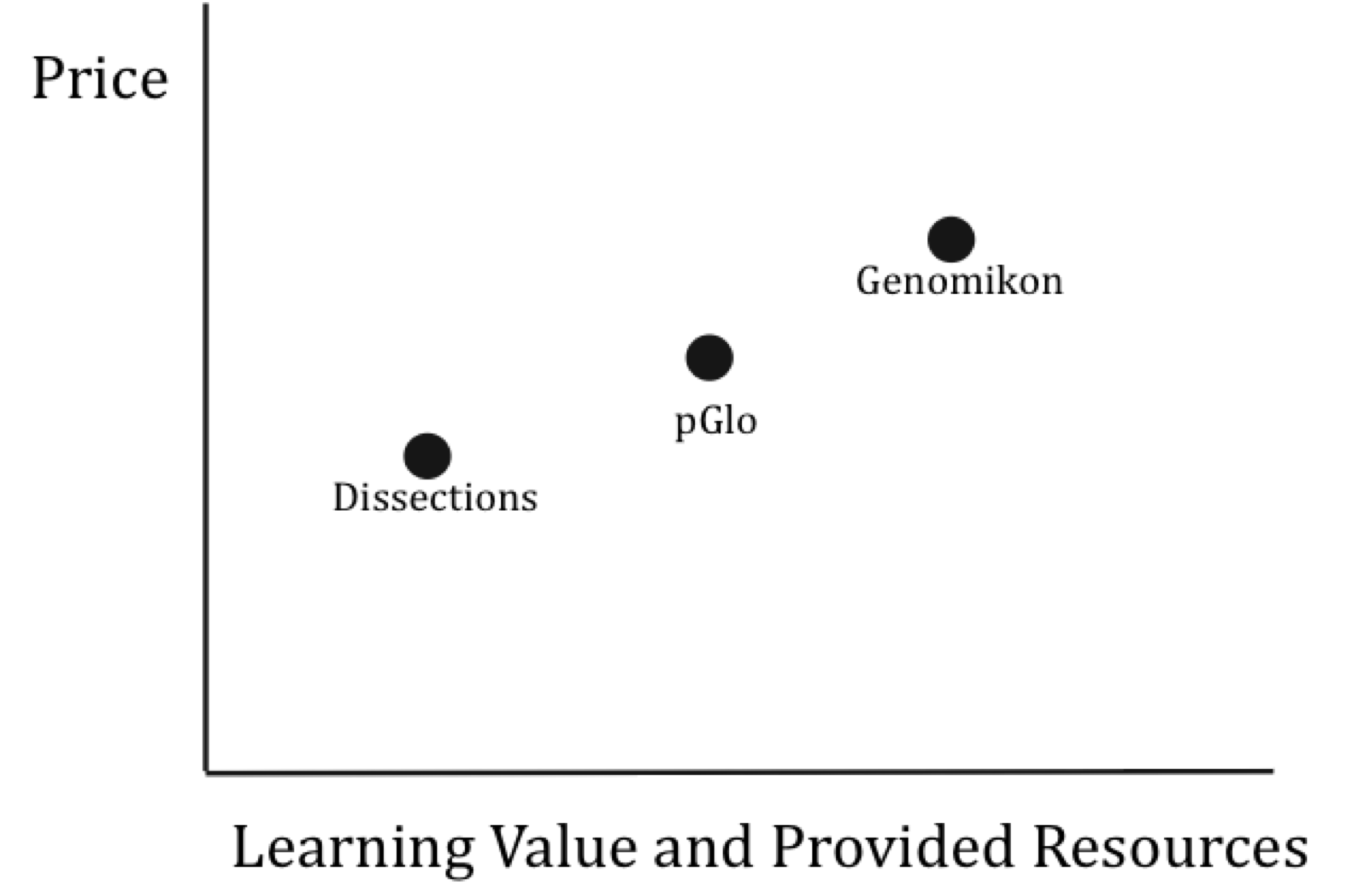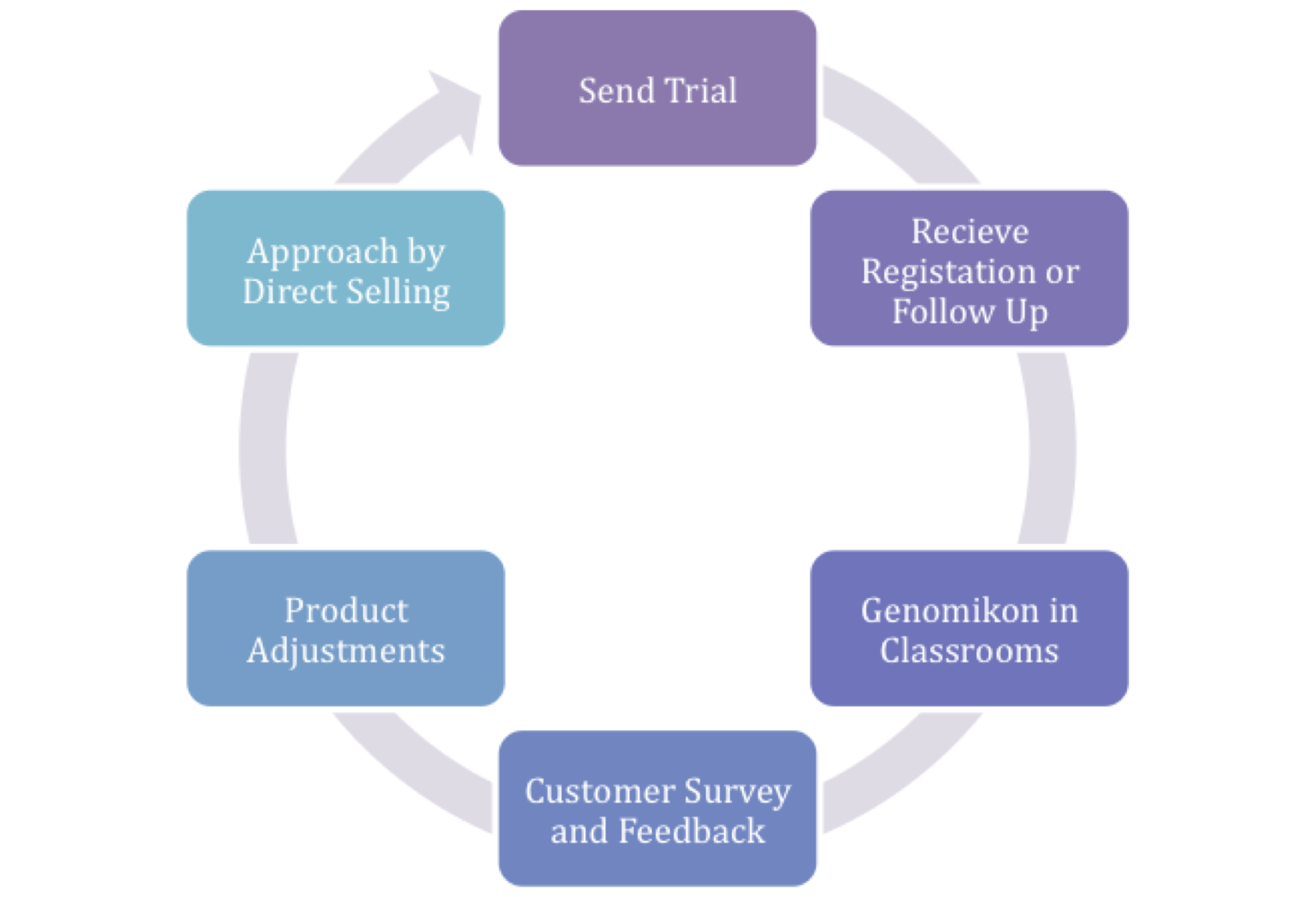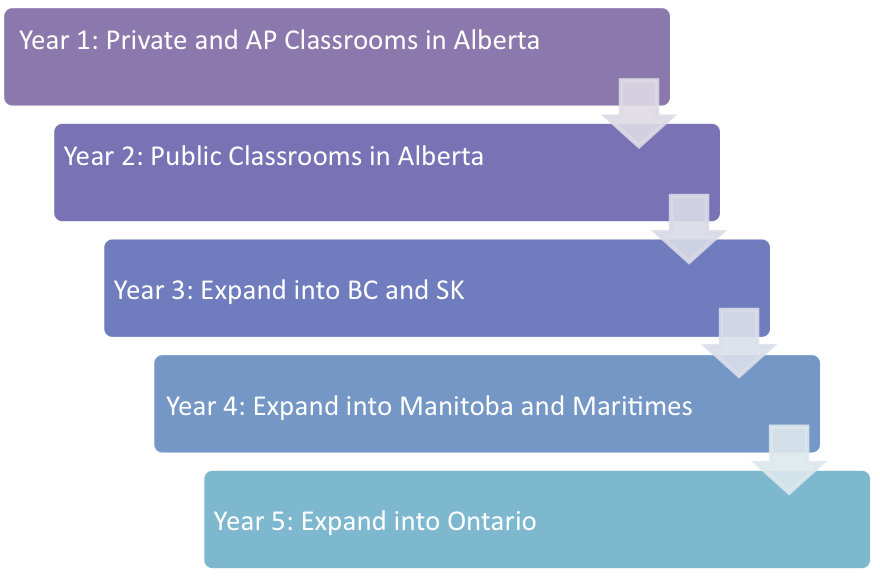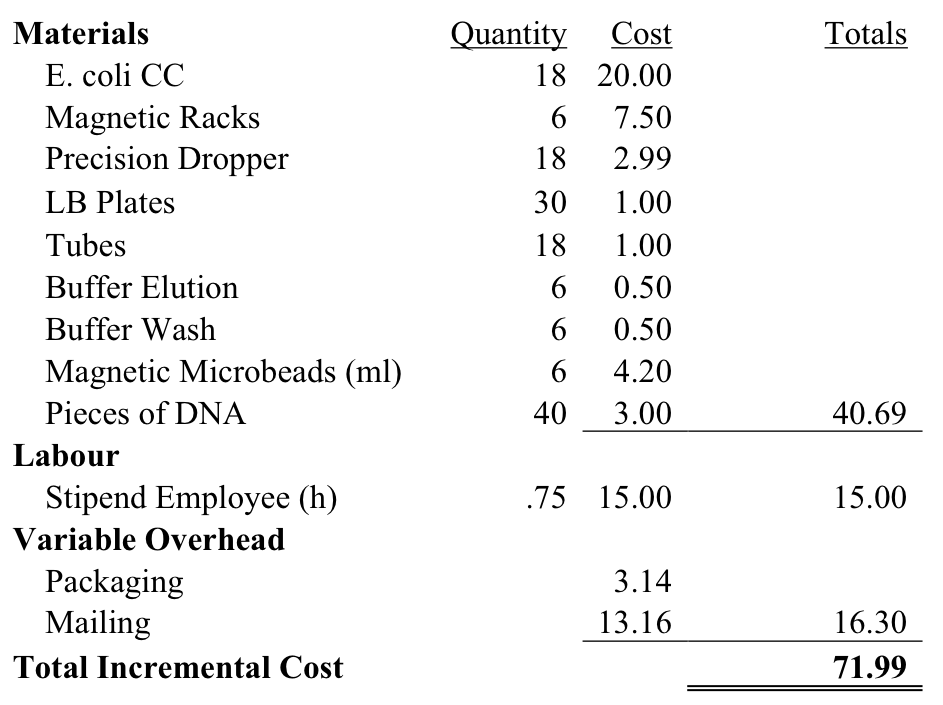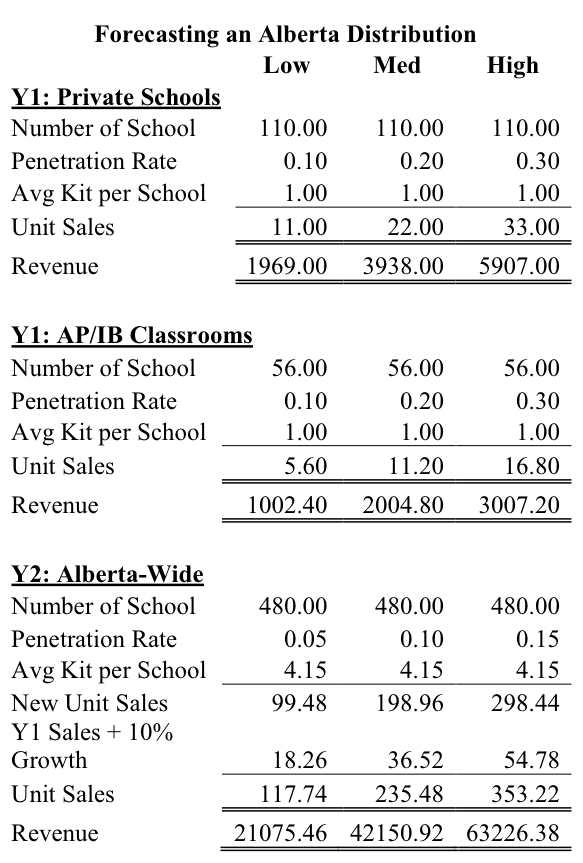Team:Alberta/human practices/distribution analysis
From 2010.igem.org
The Distribution Plan
GENOMIKON has wide applications in a variety of settings. Its most powerful application is clearly in high school education. With this in mind, our team researched and compiled a distribution plan in an effort to provide a way in which GENOMIKON can reach students. It includes a cost analysis of the components needed to produce the kit, the existing market for the kit, potential competitors, the sustainability of the market, and a three year plan for bringing the kit to high schools across Canada. We believe GENOMIKON has the potential to excite thousands of students, thus allowing them to not only learn more about synthetic biology, but also have the opportunity to gain a first taste of the field.
Click Here To Download a PDF Version of the Distribution Plan
Executive Summary
GENOMIKON is a product that will introduce high school students to the world of synthetic biology in a hands-on experience. Packaged as a complete biology lab kit, GENOMIKON will allow anyone to construct a plasmid without special equipment or advanced knowledge. This educational kit will, literally, bring life into the classroom and revolutionize the way students learn about DNA.
The University of Alberta iGEM team has developed a method of DNA assembly that is modular, rapid, and inexpensive. Genetic parts are adapted into a kit called GENOMIKON. This kit will allow students to rationally design and create functional plasmids.
GENOMIKON focuses on two procedures- DNA ligation and bacterial transformation. This means that students will be able to join functional pieces of DNA and insert them into harmless E. coli bacteria, where they can be expressed as colours and scents. GENOMIKON’s flexibility will accommodate these predesigned experiments, but foster new creative expressions as well. A comprehensive online lab manual accompanied by an interactive website, will clearly explain the procedures, effects, and cautions of the experiments.
Our project not only seeks to optimize current procedures of synthetic biology, but will also expose a new generation of students to this exciting and practical field. By designing a high school level kit and making synthetic biology accessible to this level of classroom, further research can be funded through the profits and, more importantly, we will attract new and inquisitive minds to the field.
GENOMIKON is a learning tool that provides opportunities consistent with Canada’s Education goals. In particular, GENOMIKON is a natural fit into the high school biology curriculum (Biology 30 in Alberta). Furthermore, the sheer number of schools in Canada (about 5000 that offer grade 12 studies), creates a significant market for GENOMIKON to be distributed into. The United States market presents an additional 20,000 schools to sell to.
GENOMIKON will be first introduced to private high schools and Advanced Placement (AP) classrooms in Alberta, as a test market. After one year of use, the market will expand to include public school Biology 30 classrooms. Introducing GENOMIKON to these two school systems first will decrease the perceived risk associated with the product, easing its distribution into public schools.
Overall, GENOMIKON represents a strong value offering for the high school biology curriculum. Allowing students to actually manipulate DNA and learn in a laboratory setting makes the course material more relevant and will attract young, inquisitive minds to the field of synthetic biology.
The Product
GENOMIKON is an innovative product in the world of synthetic biology and especially in a high school lab setting. Using this kit, along with an interactive companion website, students will be able to perform DNA ligation and transformation. Kits will be packaged in such a way that they are sufficient for one classroom, assuming an average class size of 25-30 students and lab groups of 4 to 5 students. The following is a list of contents included in GENOMIKON:
Included in the kit’s cost is access to an online interactive manual, found at GENOMIKON.ca, which allows students to customize their constructs. This website is part of GENOMIKON’s value offer — it uses current web technology to make the lab experience both memorable and relatable to this tech savvy generation.
When the students receive the kit, they have pieces of linear DNA. Each piece of DNA encodes proteins that will transform the cells with various instructions, such as to turn a cell a particular colour. But, individually, these DNA pieces cannot do anything. What the student needs to do then, is construct those DNA pieces into a circular chain and insert them into E. coli to see the DNA manifest its characteristics.
E. coli have their own genome (DNA), and also tiny genomes called plasmids. Taking the nutrient-rich agar Petri dish and incubating it will allow the E. coli to respond to the transformation and for the student can witness the change. Depending on what the students inserted — red protein, green protein — different colours or phenotypes of E. coli will grow. As the E. coli grows, the student will be able to see the E. coli develop. It may appear as a series of specks, which are actually colonies.
The significance of this lab is that it will allow students to transform DNA into E. coli cells, demonstrating binary fission and genetic manipulation and engineering.
Competitive Analysis
Given a school’s often limited budget, competitors in this case are loosely defined as any biology lab a science department could choose to purchase instead of GENOMIKON.
The primary competitor in this case is pGLO, produced by Bio-Rad. pGLO is an educational kit that allows high school students to insert a plasmid into (transform) E. coli. This plasmid contains a gene encoding the Green Fluorescent Protein, which glows bright green under UV light. If the transformations are successful, the colonies of E. coli will fluoresce green. The difference between pGLO and GENOMIKON is that, in pGLO the plasmid that contains the novel phenotype (Green fluorescence) is pre-made. All the students have to do is transform (insert) it into their competent E. coli and let them grow overnight. With GENOMIKON, the students will be able to build their own plasmids in their high school lab and confer various novel phenotypes, of their choice, into their E. coli. After building their own plasmids with GENOMIKON, the two kits are very similar. So, the primary difference is that, with GENOMIKON, students construct their own plasmid, therefore, adding to the learning value of the kit.
In addition to not teaching the structures of DNA that allow it to function biologically, the secondary weakness of pGLO is that every group has the same outcome—green E. coli. Furthermore, it does not have a complimentary website, providing GENOMIKON with an advantage. Students however, find pGLO a very unique and interesting lab as they get to change E. coli. The experiment is reliable, and pGLO offers a “wow factor” to the students using it as they see their E. coli glowing green. Also, pGLO requires one less class to complete than GENOMIKON.
pGlo’s market price is currently US $139.00, which is not very expensive. However, in a small convenience sample of former AP and IB students, only 4% had seen and used pGlo in high school. Therefore, despite the low cost, it is not widely distributed or pushed in the market. Clearly, there is a market opportunity. GENOMIKON’s much more in depth look into the processes of ligation and transformation, along with the online lab supplement, give GENOMIKON more intangible characteristics that provide a superior and more rounded learning experience.
The following chart demonstrates the advantages GENOMIKON has compared to pGlo that will be used to position GENOMIKON against this competitor:
Less direct competitors include dissection kits. Given that GENOMIKON serves such a different learning objective than these dissections, they are competitors only in the sense that they are pre-established in the school curriculum and are an alternative source of budgetary spending. The advantages that GENOMIKON has on this area of competition is that it is less controversial, provides more learning resources with an online supplement, and has fewer waste concerns.
The following perceptual map demonstrates the positioning of GENOMIKON relative to these competitors based on learning value and price:
Market Analysis
We feel that the high school education system is a strong launching pad for GENOMIKON. The value offer of our product is adept to serve the goals of the education system as defined by the Common Framework of Science Learning Outcomes K to 12: Pan-Canadian Protocol for Collaboration on School Curriculum (1997):
- encourage students at all grade levels to develop a critical sense of wonder and curiosity about scientific and technological endeavours
- enable students to use science and technology to acquire new knowledge and solve problems so that they may improve the quality of their lives and the lives of others
- prepare students to critically address science-related societal, economic, ethical and environmental issues
- provide students with a foundation in science that creates opportunities for them to pursue progressively higher levels of study, prepares them for science-related occupations and engages them in science-related hobbies appropriate to their interests and abilities
- develop students of varying aptitudes and interests a knowledge of the wide spectrum of careers related to science, technology and the environment.
In particular, please see appendix one for a course description, themes, and goals in the Alberta Biology 30 course. Furthermore, Appendix 1 shows the breakdown of schools by authority (private, public etc), and next by grade. From these exhibits we can derive the following demographics for Alberta:
- There are 56,482 grade 12 students
- 110 Private schools that offer grade 12
- 436 Public Schools that offer grade 12
- 30.7% of schools offer grade 12
In the 2004-2005 school year, there were approximately 15,200 elementary and secondary schools in Canada . By applying this 30.7% ratio to the number of schools in Canada, we can estimate that there are approximately 4666 schools in Canada that offer a grade 12 curriculum.
On average, we assume that high schools will offer Biology 30 3 times/year, with an average class size of 30 students. Given these assumptions, there is an opportunity to sell approximately 14,000 Genomikon kits in Canada per year, once national distribution is achieved.
Alternatively, we can approach a market estimation based on the number of students enrolled in Biology 30. In any given year there are 430,000 students enrolled in Biology 30. Given that a GENOMIKON kit is for the use of 30 students, this approach also reveals an opportunity to sell approximately 14,000 kits per year.
Furthermore, after achieving national distribution in Canada, GENOMIKON will begin its expansion into the American market. In the United States there are an additional 20,360 schools offering a grade 12 curriculum (please see Appendix 3).
What can also be surmised is that there is a vast opportunity to reach out to high school students with GENOMIKON and peak their interest in the field of synthetic biology. Among youth aged 20 to 22 in December 2001:
- 36% had participated in a college/CEGEP program;
- 33% had participated in a university program; and
- 18% had participated in some other type of postsecondary program
Based on these statistics the majority of youth attend some sort of post-secondary program within 3-4 years after graduating from high school. Introducing GENOMIKON into the classroom before students graduate provides a spectacular chance to inform Canada’s youth about the innovative and evolving field of synthetic biology and will convince some portion of those students who attend a postsecondary program to pursue their studies and career in this subject area.
Marketing Strategy
As GENOMIKON is an innovative product, the perceived risk and cost associated with the purchase of the product will be quite high. Furthermore, selling to trades such as education will require personal selling techniques and trade shows. This form of reaching the target segment can be both time consuming and costly. Additionally, we will need to plan approaches in good timing with school buying cycles so that GENOMIKON is on their mind as they are ready and have the available budget to make purchase decisions. Therefore, market infiltration will be need to taken in steps, aided by extensive research at each level. GENOMIKON will require a well defined and innovative test market where those consumers can try the kit and potentially be future endorsers in future markets.
GENOMIKON will be first introduced to private high schools and AP Classrooms in Alberta. These classrooms are the “innovative consumers” of the educational consumer segment. These segments of the education system have been selected by psychographic segmentation as academic leaders in their field. Private and AP classrooms are more likely to adapt innovative learning techniques, and have higher resources to do so with. It is imperative then that we reach this segment first. Reaching out to this segment first will aid GENOMIKON in diffusing through the other school boards, as the prior involvement of these classrooms will encourage public schools to get involved.
We have narrowed the market to Alberta schools at first. This is because locality allows better control and customer management, which will be imperative in the first two years. After one year of use we will conduct a comprehensive customer survey and make any amendments necessary. This will then lead to expansion of the market to include public classrooms in Alberta. Again, at the end of the academic year we will conduct a second customer survey to gather as much feedback as possible before beginning a national campaign.
We will need to approach each school or authority directly—through phone surveys and interviews, direct mail, email, or at education fairs. By these methods we will encourage schools to sign up for a trial kit. The trial kit will include all the necessary equipment to perform two to three experiments, allowing the respective biology professors to explore GENOMIKON capabilities and learning value, as well as alleviate risk concerns associated with a new product. This also allows them an opportunity to become familiar with the product—see it work and envision how they can use it in their classroom. With the trial kit will come a registration and order form to acquire full size GENOMIKON kits for their classrooms. If the school does not send in this form within three weeks of requesting the trial, we will contact them by phone for feedback or to directly register them over the phone. As mentioned previously, after the school has used GENOMIKON kits in their classrooms we will conduct a comprehensive survey of teachers and students to gain feedback and make any necessary revisions before expanding. The method of contacting and registering schools to receive GENOMIKON is outlined in the circle diagram seen above:
This cycle will be repeated as we continue to expand by the following schedule:
After achieving national distribution in Canada, GENOMIKON will begin a new launch into the United States, where there is an even larger market. Most methods (approach, trial, registration), will remain similar during US expansion. However, with 5 years of selling underway there should not be a need to move as slowly geographically. The sales and customer reviews GENOMIKON receives from the Canadian market will help to support a faster expansion into the United States.
Financial Information
iGEM facilitates both foundational advances and educational outreach in the field of synthetic-biology; the commercialization of GENOMIKON, as an educational product, will further these developments. GENOMIKON is a revolutionary product that will bring true synthetic-biology to the classroom, but it also has potential to fund further research and development by the University of Alberta’s iGEM teams.
Our vision is for GENOMIKON to be distributed to schools across North America, with revenues supporting further research and development and the University of Alberta iGEM team. In doing so, we can expose hundreds of thousands of high school students to the wonder of synthetic biology.
Through a competitive analysis, GENOMIKON has been deemed to have superior functionality to comparable products like Bio-Rad’s pGLO. GENOMIKON can also be produced and sold at a competitive price. Variable production costs for one GENOMIKON kit are as follows:
Consider the costs of two alternative products, pGLO by Bio-Rad and common bullfrog dissections, compared to GENOMIKON at a proposed price of $179:
Even when priced at $179, which allows over $100 per kit for overhead and reinvestment, GENOMIKON's cost per student is comparable to the competition. Given GENOMIKON's superior capabilities and additional features, it could easily be priced at a further premium. In a given year, Canada has approximately 430,000 Biology 30 students; this represents a market worth over $2,500,000. Secondary schools in Alberta receive $8,065,000 in funding for Bio-30 credits; this extrapolates to over $90,000,000 in Canada. A large and apparent market exists for GENOMIKON.
Based on the marketing plan illustrated above, a GENOMIKON distribution could look as follows. The three columns illustrate more-and-less conservative forecasts of sales. This Sales Forecast projects the unit sales and revenue for the Alberta distribution in years 1 and 2.
It is plausible that, by year two, GENOMIKON would expose up to 10,000 students per year to synthetic-biology, while raising tens of thousands of dollars for further research. The Forecasted Statement of Activities that follows has been derived using the previously-mentioned Sales Forecast and Incremental Product Costs. All expenses are based on reasonable estimates for the operations of such a business, using office space and services available to University of Alberta-affiliated groups.
This extremely conservative forecast shows that GENOMIKON, while showcasing synthetic-biology to thousands of students across the Province of Alberta, can generate revenue to support further research, at minimal levels of sales.
Risks & Mitigation
Health and Safety Concerns
Laboratory E. coli is a well-characterized bacterium that is used in many labs worldwide. The strain of E. coli used in GENOMIKON is classified as having a biosafety level of 1; the lowest. In fact, the existing lab kit produced by Bio-Rad puts E. coli cells to use.
Facilities required to contain risk group 1 organisms are:
- Containment Level 1: No special facilities, equipment or procedures are required. Standard well-designed experimental animal and laboratory facilities and basic safe laboratory practices suffice.
- Hand-washing facilities must be provided.
- Disinfectants must be properly used
Therefore, all properly equipped lab classrooms have the requirements and procedures to contain the risk associated with the strain of E. coli currently used in GENOMIKON.
Experiment Waste Disposal
The GENOMIKON lab can essentially be cleaned with bleach. The biological waste, even in the case of contamination (say dropping a plate on the floor) can be handled by a bleach solution.
Market Rejection
A universal risk associated with introducing any product to market is the refusal of those in one’s chosen market to accept and embrace the new innovation. Our chosen course of mitigation for this risk is described in our marketing strategy above. By introducing GENOMIKON first into a small test market of private schools we can gauge more closely a response to the current version of GENOMIKON, receive feedback of what can be bettered, and make the appropriate changes. In this way, the GENOMIKON kit will have all the qualities desired by students and educators and provide the opportunity of greater acceptance by all consumers in the market.
Conclusion
GENOMIKON is an incredibly innovative product that represents an exceptionally strong value offering to its chosen market. The product introduces novel and significant processes into a high school lab setting that have never been demonstrated at such a basic level before. Competitively, GENOMIKON offers much more in the way of educational value and knowledge than lab experiments currently on the market. There is an exceedingly large opportunity for GENOMIKON to penetrate the Canadian and American education systems and expose tens of thousands of students to the wonders of synthetic biology. With a focused strategy, the distribution of GENOMIKON will be thoroughly successful and greatly rewarding to educators, students, and GENOMIKON creators.
 "
"


